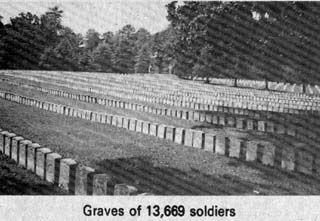May 4, 1978




Picture #1 – Graves of 13,669 soldiers
Picture #2 – Original Andersonville site
Picture #3 – Closeup of Providence Spring which is still flowing
Picture #4 – Two Ohioans graves
Picture #5 – Building housing spring
Most readers know something about the terrible Civil War in this country that set the North against the South…having studied it in school history courses or having heard certain stories of it passed on by parents or grandparents.
One such story was mentioned to me by Fostorian Blake Myers sometime ago… it concerned Providence Spring…the flowing spring of water that turned the tide when Northern soldiers were dying by the scores every day because of sickness caused in part because of impure water.
Myers’ story set me researching, and I finally visited the site of Providence Spring at Andersonville, Ga., where Northern prisoners were held during that tragic war.
Let’s start at the beginning.
Andersonville, the largest and best known of Southern military prisons was located in Sumpter County, Ga., at Station on the Southwestern Railroad (now Central of Georgia) nine miles northeast of Americus.
It was selected as a prison site because Confederate officials foresaw the need to move Northern prisoners from Richmond and other prisons farther north in the event of a breakthrough by Northern forces. They felt it would be easier to guard them in a remote area. The new prison site was also selected because of the close proximity of the railroad, the presence of plenty of pure water and warmer climate.
Confederate soldiers and slaves from nearby plantations began clearing the land and constructing the camp January 1864. In February, before the prison was near completion 500 Northern troops arrived. Soon more prisoners were arriving at the rate of 400 per day. By August, 32,000 Northern soldiers were incarcerated in the 26 acre camp that was meant to hold 10,000.
In addition to overcrowding, there was inadequate shelter, food, doctors and means for treating the sick and injured. Mostly, the prisoners had to construct their own shelters from whatever scrap materials they could find. Many prisoners had clothing that was in tatters, and often they were naked.
Food was rationed meagerly and left to the prisoners to cook. Those who had money could buy food from the prison sutler and other merchants who had setup shops inside the stockade.
The stream of water that supplied the camp soon became polluted by human wastes and other pollutants. Diarrhea and dysentery spread throughout the camp. Deaths from those ailments, as well as from gangrene and other diseases, occurred by the scores…the greatest toll being 90 on August 23; 1864.
A group of Christian prisoners finally decided they would pray to God for pure water and would not stop until their prayers were answered. They prayed for hours…and then finally a deafening noise like thunder or an earthquake shook the earth, and where they were kneeling a stream of water burst forth from the ground. They considered this phenomena a providential act of God… and so the stream of water was called Providence Spring.
Blake Myers’ grandfather was one of those in the prayer group and that is the story he told Blake when he was a boy, anxious to hear his grandfather’s stories.
One of the historical accounts reports that the spring was originally there, but had been covered over when the camp construction work was in progress. Nevertheless, those who prayed for water believed God’s providential act provided an answer to their prayers.
Providence Spring has continued to flow all these years since 1864 and was flowing the day I saw it in March of this year.
A powerful Union force under General James H. Wilson, captured Columbus, Ga. April 17, 1865, and shortly thereafter all Northern prisoners at Andersonville were freed.
The prison grounds reverted to private ownership, but after the war was purchased by the Grand Army of the Republic (GAR) in 1890. The GAR and its auxiliary the Women’s Relief Corps, made many improvements to the old prison site. Clara Bartoh, a famous Civil War nurse helped to identify and mark the graves of those who died at Andersonville. Additional interments, including the remains of Union soldiers originally buried in other Southern prison camps, were later moved to Andersonville, and today there are 13,669 marked graves at the National Cemetery.
This cemetery, now comprising 84 acres, was administered by the U.S. Department of the Army until 1970, at which time it was turned over to the National Park Service. Department of Interior. It is well maintained and worth visiting.
The Women’s Relief Corps in 1901 donated the pavilion that houses Providence Spring, in memory of those who died at Andersonville. A plaque inside the building reads: “This pavilion was erected by The Women’s Relief Corp, Auxiliary to the Grand Army of the Republic in grateful memory of the men who suffered and died in the Confederate prison at Andersonville, Georgia from February 1864 to April 1865. The prisoners cry of thirst rang up to Heaven, God heard, and with His thunder cleft the earth and poured his sweetest waters gushing here”.
The National Association of Union Ex-Prisoners of War erected the fountain within the pavilion, which is connected to the original spring of water.
1.065 Union soldiers from Ohio are buried at Andersonville. Complete records at the headquarters building are available for those who wish to locate the burial sites of relatives.
The complete and very interesting story about Andersonville Prison is told in literature and booklets, as well as by photos, available there. Space here does not permit a more complete story and pictorial presentation.